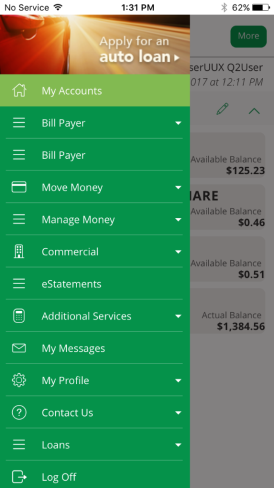Q2 SMART release notes
Campaign Builder (4.3.0)
What's new
- Updated the heading of step 1 in the Campaign Builder from Build a custom campaign to Build a campaign due to the removal of Recommended Campaigns. (ECOM-8310)
- Updated the email column of the campaign export. If an email address exists for the user in the Q2 database, the email column will include it in the corresponding field. If there is no email address, the field will be blank. If there was an issue accessing the email addresses from the Q2 database when the report is exported, the field will return an "Unable to retrieve" message. (ECOM-8134)
- Updated the Q2 SMART login window to indicate that login credentials can be managed in Q2 Console Administration. Previously, all login permissions and entitlements for Q2 SMART were managed in Q2central; now, these have been moved to Q2 Console Administration. (ECOM-8206)
Audience Builder (1.5.3)
Fixes
- Fixed an issue where, when the audience's detail page failed to populate, the audience export displayed an incorrect error message. Now, when Audience Builder fails to populate an audience's detail, the query for the audience displays as "There was a problem with this audience. Please contact support." (ECOM-8138)
- Fixed an issue where a product trait could be deleted after being added to an audience, which resulted in the audience query returning an error. Now, the audience query parses correctly and returns the correct user count. (ECOM-8225)
- Fixed an issue where Q2 SMART incorrectly rejected uploaded Q2 Discover visitor lists. Now, Q2 Discover visitor lists are processed as valid. (ECOM-8284)
Campaign Builder (4.2.0)
What's new
Added new Conversion value field to step 1 of the Campaign Builder workflow
Q2 SMART has added the Conversion value field to step 1 of the Campaign Builder, to the campaign export, and the campaign report UI.
The conversion value is the monetary amount assigned to each conversion (in USD) for a specific campaign, which assists in determining an individual campaign's return on investment (ROI).
The conversion value field is only available for the types of campaigns that allow tracking of conversions and adoptions. The conversion value field only shows after the user picks a campaign type that records conversions, otherwise a message that says conversions and adoptions are not recorded for that campaign type will display.
The total conversion value for a campaign is the conversion value multiplied by the number of conversions. The total conversion value is reflected on the campaign export and on the campaign's report page.
For more information, see Conversion values.
(ECOM-8116, ECOM-8117, ECOM-8182)
Added conversion-value to SMART API
The SMART API endpoint Campaigns by user now includes conversion-value in the response "conversion-value: <float>". (ECOM-8115)
Additional changes
- Added a loading spinner to the Overview card for Audience size when selecting an audience for a campaign. The spinner serves to inform users when the audience size calculation is in process and helps determine loading time. (ECOM-7773)
Fixes
- Fixed an issue where the external API call to the heuristic traits returned an error for certain traits' enum values. (ECOM-8231)
Audience Builder (1.5.1)
What's new
- Added character limits of 100 characters to user list names and 400 characters to user list description entries. These character limits are reflected in the UI. (ECOM-7537)
- Updated user list cards to detail more information on when the list was uploaded, by whom, and when the list was last updated. This additional information is also reflected on the user list modal when uploading new users to the list. (ECOM-7997)
Fixes
- Fixed an issue where audiences included an inflated number of users when they had certain traits but did not have the corresponding Boolean trait. Now, when certain traits are assigned to an audience, the corresponding Boolean traits are automatically included, so the audience count returns accurately. (ECOM-8047)
- Fixed an issue where duplicate users contributed to the audience size in user lists. Now, when a user list contains duplicates, the duplicates are removed from the audience size during the validation process, and the UI displays how many duplicates were removed from the validation. (ECOM-8066)
Campaign Builder (4.1.0)
What's new
- In Step 1 of Campaign Builder, users are now informed when their selection for the What would you like to do? field will not result in adoptions or conversions.
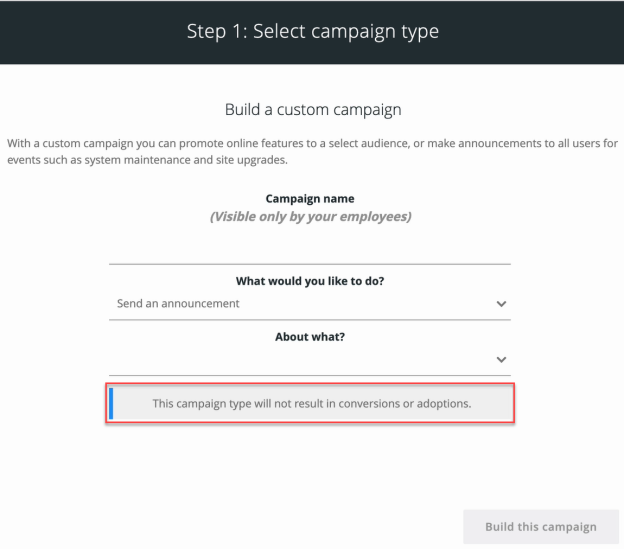
(ECOM-7981)
- Updated the names of traits as they appear within the product tagging overpanel to match how they appear within the trait overpanel. Now, the names of traits are consistent across both overpanels. (ECOM-8048)
Fixes
- Fixed an issue where Q2 SMART surveys did not successfully open on mobile devices. (ECOM-8135)
Campaign Builder (4.0.0)
What's new
Retired the legacy campaign building experience
Legacy campaign-building has been decommissioned and the toggle between the experiences has been removed. As previously communicated, any campaigns built on the Legacy version have been archived and are no longer available.
(ECOM-8062)
Audience Builder (1.3.0)
What's new
Added new trait to the Trait Store
- Annual deposited income—This trait describes the estimated annual deposited income for a user based on the deposits made to all their consumer accounts at the financial institution. (ECOM-8024)
Audience Builder now permanent and Legacy campaign-building decommissioned
Q2 SMART Audience Builder is now permanently enabled.
(ECOM-7978)
Information added to audience exports
The audience export now includes the following information:
- Audience trait queries—the report displays the query summary for the traits that are included and excluded for that audience at the time of export.
- User email addresses—if an email address exists for the user in the Q2 database, the email column will include it in the corresponding field. If there is no email address, the field will be blank. If there was an issue accessing the email addresses from the Q2 database when the report is exported, the field will return an "Unable to retrieve" message.
(ECOM-7995)
Fixes
- Fixed an issue where an invalid identifier in an uploaded user list caused all traits to not process in Q2 SMART. Now, all trait data processes as expected. (ECOM-8089)
What's new
Legacy campaigns to be decommissioned, Audience Builder to be permanently enabled
On April 30, 2024, Q2 SMART™ will depreciate legacy campaign builder. At that time, Audience Builder will be permanently enabled and all data on the legacy version will be removed.
What does this mean?
- Active campaigns built in the legacy campaign builder will be obsoleted.
- All campaigns built in legacy campaign builder will be hidden.
- Campaigns built using Audience Builder will operate unaffected and will remain visible.
- Building campaigns using Audience Builder will be the only way to build campaigns.
- We will continue to enhance Audience Builder going forward.
What should I do to prepare?
-
Enable Audience Builder and, going forward, build all campaigns using Audience Builder.
-
Download any data you think you might want from legacy by April 29, 2024.
-
Recreate existing campaigns in Audience Builder so that you do not lose your data.
Updated Audience Builder toggle to now be enabled by default
To encourage the use of campaigns built with Audience Builder, the toggle now defaults to enable Audience Builder every time you log in or refresh the page. If you do not have any campaigns built with Audience Builder, your home page will be blank. Your legacy campaigns can still be viewed and edited with the toggle turned off. (ECOM-7950)
Added ability to download audiences in Audience Builder
- You can now download an audience in Audience Builder as a comma-separated values (CSV) file. To download an audience, select
 Download audience from the audience tile menu
Download audience from the audience tile menu  or select
or select  Download audience on the audience details page.
Download audience on the audience details page.
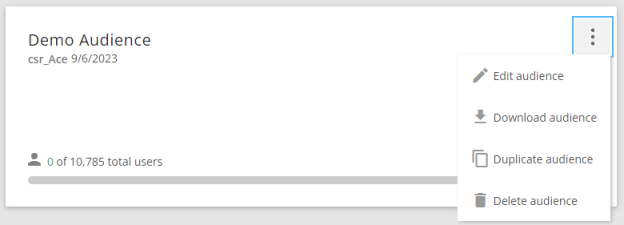

(ECOM-7922)
Additional changes
- Removed Biller Direct traits from the Trait store due to the sunsetting of the Q2 Biller Direct product. (ECOM-7772)
Added new trait to the Trait store
- First login date—This trait describes when the user first logged into digital banking. Users whose first login date is before their FI joined Q2, or before October 12, 2022, will have the user enrollment date applied instead. (ECOM-6464)
This release includes the following updates:
What's new
Added Audience Builder support for user lists
You can now add user lists to audiences built in Audience Builder. As in the Legacy workflow, user lists are located within the Trait window for building an audience.
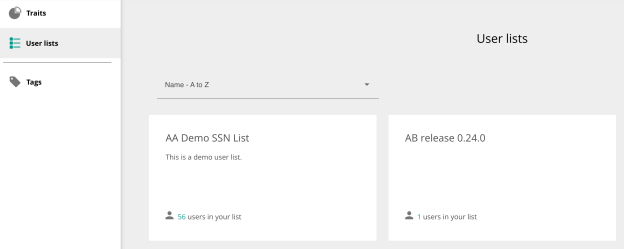
(ECOM-7496)
Additional changes
- Updated the Save and Cancel buttons to float when scrolling the page throughout the Q2 SMART workflows so that the buttons remain visible at all times. Additionally, for increased visibility, the color of the Save button has been updated to match the FI's theme color.
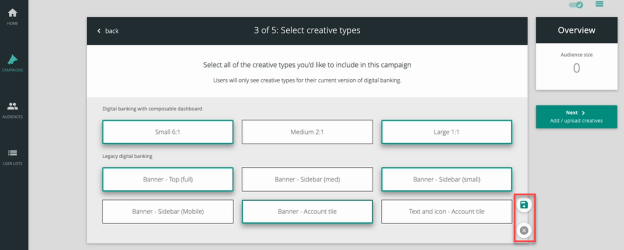
(ECOM-7847) - Updated the description of the Number of Favorited Accounts trait to indicate the new number of accounts a user can favorite in UUX. Previously, a user could favorite up to 5 accounts. Now, a user can favorite up to 20 accounts. Note: This trait is only applicable to Composable Dashboard participants.(ECOM-7920)
- Added users' email addresses to the export of a campaign report as the "B" column. If no email address exists for a user in the database, then the cell is empty. To accommodate this change, the column data in the export file shifts over one column. (ECOM-7708)
- Added an export button to the product tagging page, which allows a CSV of current product tags to be downloaded. This provides FIs with an additional way to view how their products are tagged and which products are untagged.
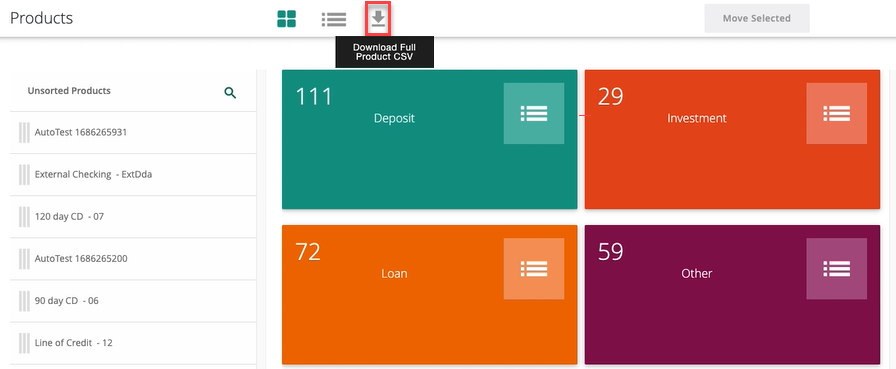
(ECOM-7761)
Fixes
- Fixed an issue where users' email addresses were removed from Survey campaign reports. (ECOM-7869)
This release includes the following updates:
What's new
Introducing Audience Builder
The introduction of Audience Builder is the first step in Q2 SMART’s modularization of the campaign building workflow. By separating audience-building from campaign-building, we allow for:
- One audience to be used multiple times or for multiple campaigns.
- The ability to target Composable Dashboard content blocks, allowing a personalized banking experience for the user.
As part of this modularization, Q2 SMART has made significant enhancements to the audience building capabilities:
- New trait modal with enhanced numeric filtering
- Trait organization through trait tagging
- Global trait-search functionality
- AND/OR statements with traits for enhanced audience segmentation
- Ability to view trait descriptions
To toggle Audience Builder on or off, select the on/off toggle (![]() ) located near the main menu (
) located near the main menu (![]() ). This toggle allows you to switch back and forth between the new Audience Builder experience and the Legacy audience creation workflow.
). This toggle allows you to switch back and forth between the new Audience Builder experience and the Legacy audience creation workflow.
Preexisting campaigns that were not built with Audience Builder will now be referred to as Legacy Campaigns. These campaigns will not be available in Audience Builder.
Additionally, user lists will not be available in Audience Builder until a future release. Campaigns requiring a user list should continue to be created and utilized in Legacy Campaigns.
For more information regarding Audience Builder and the subsequent changes to Q2 SMART, visit Audience Builder and the Audience Builder section of the Q2 SMART FAQs.
Added new trait to the Trait Store
- Spike in spending - auto repair expenses—This trait indicates a recent spike in auto repair expenses (part stores, repair shops, towing, etc.) over the last 3 months when compared to prior quarters over the past year. A True value occurs if there’s a spike in spending. A False value occurs if there is normal spending. An Unknown value occurs if a spike cannot be determined due to an insufficient amount of available spending history. (ECOM-7613)
Additional changes
- Added styling to the User list dashboard that visually indicates if the user list is actively processing the number of users. (ECOM-7501)
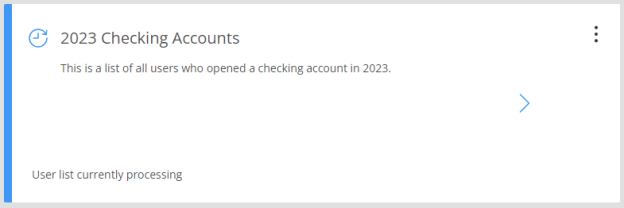
Fixes
- Fixed an issue where product names from Q2 databases were not populating after a change in core configuration, which resulted in retagging errors within the product tagging interface. Now, product names are populating as expected and products can be tagged appropriately. (ECOM-7821)
- Fixed an issue where email addresses didn't display in survey campaign reports. Now, email addresses should appear as expected. (ECOM-7861)
- Fixed an issue where false adoptions appeared in the campaign report, which resulted in conversions being higher than adoptions.
(ECOM-7566) Note: This fix doesn't clear up existing false conversions, but rather prevents future false conversions from occurring. For more information, see Interpreting report data.
This release includes the following updates:
What's new
Added new traits to the Trait store
- Grocery transaction frequency—This trait indicates the frequency of grocery-related transactions over the last 180 days. User activity is represented by a frequency score (range 0 - 100), which is calculated by comparing an individual user's frequency value to the normalized frequency values of all users.
- Auto maintenance transaction frequency—This trait indicates the frequency of auto maintenance transactions (gas, oil changes, car washes, etc.) over the last 180 days. User activity is represented by a frequency score (range 0 - 100), which is calculated by comparing an individual user's frequency value to the normalized frequency values of all users.
- Utilities transaction frequency—This trait indicates the frequency of utility-related transactions over the last 180 days. User activity is represented by a frequency score (range 0 - 100), which is calculated by comparing an individual user's frequency value to the normalized frequency values of all users.
- Common transaction frequency—This trait indicates the combined frequency of common transactions in the grocery, auto maintenance, and utilities categories for a user over the last 180 days. User activity is represented by a frequency score (range 0 - 100), which is calculated by comparing an individual user's frequency values to the normalized frequency value of all users.
(ECOM-7657)
Fixes
- Fixed an issue where the text for the Text & icon ad space didn't display as centered on the review page of the campaign builder workflow. This issue appeared when the text character amount was near 50 characters and a URL was associated with the campaign. (ECOM-7656)
- Fixed an issue where user lists didn't upload and returned a 500 error if certain characters (<, >, &, ") were present in the list. Now, user lists containing these characters successfully upload. (ECOM-7683)
- Fixed an issue in the product tagging interface where unnamed products prevented all products from appearing. Now, all products display in the tagging interface even if unnamed products are present. (ECOM-7698)
This release includes the following updates:
What's new
Custom audiences feature is now User lists
The custom audiences feature in Q2 SMART is now called User lists. This change was made to support future product enhancements related to Audience Builder. User lists allow you to upload pre-curated groups of users into the application. Once uploaded, these lists act like fixed traits (the users included in the list do not dynamically change based on the users' behavior). You can add a user list to a campaign within the User lists tab in the Add a trait to your audience window when creating or editing a campaign.
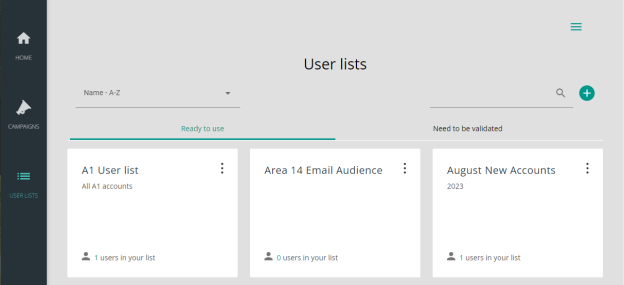
Updates to Q2 SMART workflows
This change affects the following workflows in Q2 SMART:
- Viewing user lists. To access user lists, select the button in the side menu. The Audiences item in the side menu is now User Lists and the Import a custom audience page is now titled Create a user list.
- Selecting a user list to use within a campaign. To include a user list in a campaign, select the User list tab when adding a trait to your audience and select a valid user list.

- Adding users to an existing user list. To add users to a user list, select Add users to your user list within the User list editor.
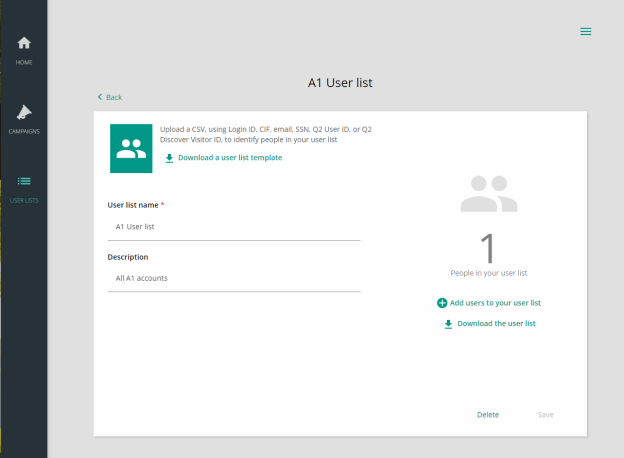
- Validating a user list uploaded using the SMART User lists API. To validate a user list uploaded using the API for use within a campaign, select User lists from the side menu, then select the Need to be validated tab. This tab contains user lists that were uploaded using the SMART API that still need to be validated before they can be used. This tab will not appear if no user lists have been uploaded that are in need of validation. Refer to Validating a user list for more information.
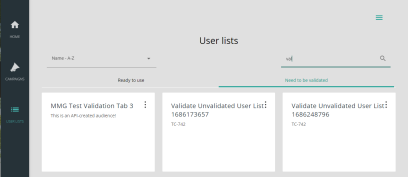
- Uploading a user list using the Q2 SMART application. To upload a user list, select User lists in the side menu. A template user list is available to download, and you can select what identifier to use to match users to your FI's database. Files uploaded using the UI are validated during upload.
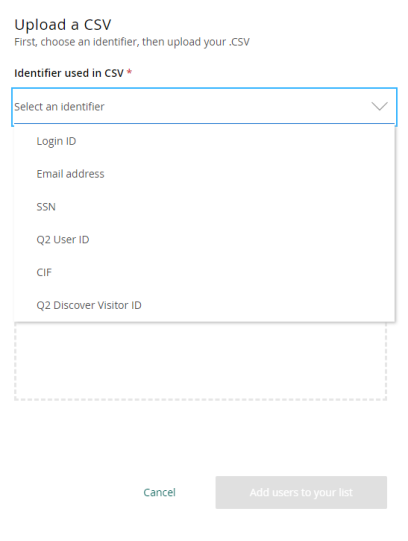
- Downloading a user list. To download a CSV file that includes a list of Q2 User IDs that are included in the user list, select Download the user list.
- Deleting a user list. To delete a user list, select Delete from the options menu (
 ), then verify the deletion using the new confirmation dialog.
), then verify the deletion using the new confirmation dialog.
Updates to Q2 SMART APIs
The external API calls for custom audiences for GET, DELETE, and POST have been obsoleted to reflect the new feature name. This functionality is now available from the User list APIs. For more information about accessing the APIs, contact your Customer Experience Manager (CEM). You can access documentation for the Q2 SMART APIs online at smart.q2developer.com.
(ECOM-7469)
Updated the recommended audiences algorithm
Q2 SMART improved the algorithm accuracy behind the Recommended Audience traits:
- Now, if a user already has the product, they will not be included in that trait.
- If a user was previously recommended for a product, but is no longer an ideal candidate for the product based on the algorithm predictors, they will not be included in that trait.
- The Recommended Audience traits are updated weekly, rather than daily.
(ECOM-7121)
Added new traits to the Trait store
- Home Address - State—This trait indicates the U.S. state associated with a user's home address. (ECOM-7309)
Removed Usage Statistics from the side menu
On May 10, 2023, Q2 SMART removed Usage Statistics functionality in favor of accessing this information using the Q2 Console Reporting features. This change was made to simplify and improve data reporting, as the Q2 Console Reporting module offers access to the same information.
To access your data within the Q2 Console dashboard, select Reporting > Digital Banking Data. For FIs who use the CPFM product, the same data that previously appeared under Usage statistics > External Accounts in Q2 SMART is available within Feature Data in Q2 Console's Reporting module. Usage statistics for internal product data can be accessed from your FI's core.
Refer to the Q2 Console Reporting online help for more information.
(ECOM-7472)
This release includes the following updates:
What's new
-
Updated the internal logic for CPFM audiences to remove stale data and to support future improvements for CPFM data management. As a result of this change, you might experience a drop in the number of accounts included in audiences that use a CPFM trait.
Note: This issue was included in the 1.8.3.1 release, but this text was updated after the 1.8.3.1 release notes were initially published.(ECOM-7105)
Fixes
- Fixed an issue where users were no longer able to log in to Q2 SMART using Q2 Console after the Q2 Console 1.0.38 release. (ECOM-7569)
This release includes the following updates:
What's new
Added support for additional HQ login errors
To assist with troubleshooting, Q2 SMART now includes additional error messages. If you receive one of the following errors, work with your Q2central administrator or Q2's Support team to resolve it:
- "Your username or password is incorrect. For security reasons, your account may be disabled by additional unsuccessful attempts."
- "Password has expired. Please reset your password for Q2central."
- "Your account has been disabled. Please contact your Q2central administrator for assistance."
- "New user must set a password for Q2central."
(ECOM-7175)
New Composable Dashboard ad spaces available for users with EA access
Q2's Composable Dashboard feature will offer FIs the ability to define a default landing page experience for their users that consists of several pre-defined content blocks. In the future, FIs will define the order and priority of content blocks using Q2 Config, but at this time, FIs can work with Q2 to create their customized dashboard.
The SMART content blocks will display up to three new SMART ad space sizes just for Composable Dashboard. FIs can choose the size (small (768 x 128), medium (768 x 384), or large (768 x 768)) and then use Composable Dashboard to configure where to display the content relative to the other content blocks. When creating a SMART campaign, you will see a new section for Digital banking with composable dashboard when selecting creative types. All three spaces are fully responsive and will appear across devices without the need to use separate creatives.
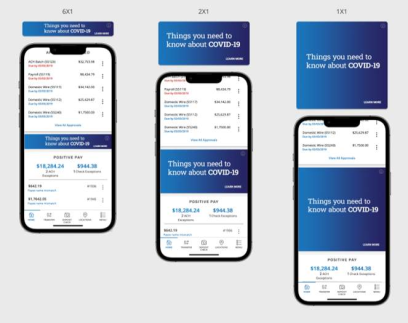
To use the Composable Dashboard within digital banking at this time, you must also have licensed the following Q2 products:
- UUX version 4.5.0.0 or later
- Mobile branding and the Mobile Thumb Bar
(UUX-34517)
Added new traits to the Trait store
- Monthly login activity—This trait describes the average monthly number of logins for a user based on the user's login activity over the past 6 months. (ECOM-7242)
Additional changes
- For FIs who are early adopters of Composable Dashboard, in step 4 of the Campaign Builder the selected ad spaces on the right-hand rail are divided into "Legacy digital banking" and "Digital banking with composable dashboard" sections similar to step 3. Additionally, steps 3 and 4 now refer to "online banking" as "digital banking". (ECOM-7079)
Fixes
- Fixed an issue where invalid product traits were set. (ECOM-7439)
This release includes the following updates:
What's new
Added new traits to the Trait store
- AutoPay enabled—This trait indicates whether AutoPay is enabled for a user based on their transaction patterns. (ECOM-7240)
- Outgoing transaction usage—This trait indicates transaction activity for a user based on their transaction patterns in the last 180 days, specifically transactions initiated through online banking activity, such as ACH, wires, and external funds transfers. User activity is represented by an RFM score (range 0 - 100), which is calculated using the average of the normalized rank of recency, frequency, and monetary values. (ECOM-7259)
Additional changes
- Changed the display name and description for the defined SAC target trait to clarify how the logic works. The new trait name is Defined Secure Access Code (SAC) target missing in UUX and the new description is "This trait indicates whether a user has not defined a Secure Access Code (SAC) target in UUX." (ECOM-7251)
This release includes the following updates:
What's new
Added new trait to the Trait store
- Bill Pay usage—This trait indicates a user’s Bill Pay usage in the last 180 days. Usage is represented by an RFM score (range 0 - 100). The RFM score is calculated using the average of the normalized rank of recency, frequency, and monetary values. (ECOM-7123)
Fixes
- Fixed an issue where some campaigns reflected false adoptions and conversions. (ECOM-6908)
- Fixed an issue where the error message did not adequately inform the user of how to address the image upload. (ECOM-7049)
This release includes the following updates:
What's new
Added new trait to the Trait store
- Number of Favorite accounts—this trait indicates how many Favorite accounts a user has (up to 5). This trait only applies to Composable Dashboard participants. (ECOM-7083)
Display names changed in the Trait store
In order to increase usability and consistency among trait names, Q2 SMART has updated some of the display names for traits in the Insights tab in the Trait store. The new trait names are as follows:
| Updated trait name | Previous trait name |
|---|---|
| Your existing users | all_users |
| E-statement enrolled | Estatement enrollment |
| Bill Pay - eligible to enroll | Users eligible to enroll in Bill Pay |
| CPFM – eligible to enroll | Users eligible to enroll in CPFM |
| Q2 Goals – eligible to enroll | Users eligible to enroll in Q2 Goals |
| Amount-driven Account alerts enrolled | Users enrolled in amount-driven Account alerts for digital banking |
| Bill Pay enrolled | Users enrolled in Bill Pay |
| CPFM enrolled | Users enrolled in CPFM |
| Date-driven Account alerts enrolled | Users enrolled in date-driven Account alerts for digital banking |
| Email notifications enrolled | Users enrolled in Email notifications for digital banking |
| History alerts enrolled | Users enrolled in History alerts for digital banking |
| Insufficient Funds alerts enrolled | Users enrolled in Insufficient Funds alerts for digital banking |
| Non-Online Transaction alerts enrolled | Users enrolled in Non-Online Transaction alerts for digital banking |
| Online Transaction alerts enrolled | Users enrolled in Online Transaction alerts for digital banking |
| Push notifications enrolled | Users enrolled in Push notifications for digital banking |
| Q2 Goals enrolled | Users enrolled in Q2 Goals |
| Recipient notification online transaction alerts enrolled | Users enrolled in recipient notification Online Transaction alerts for digital banking |
| Reminder alerts enrolled | Users enrolled in Reminder alerts for digital banking |
| SMS notifications enrolled | Users enrolled in SMS notifications for digital banking |
| Voice notifications enrolled | Users enrolled in Voice notifications for digital banking |
| Receives payroll | Users likely to receive Payroll deposits at recurring intervals |
| Defined Secure Access Code (SAC) target in UUX | Users with no defined SAC Target |
(ECOM-6374)
Usability improvements for step 3 of Campaign Builder
Previously, the ad space selection boxes used in step 3 of campaign builder were white, changing to the appropriate theme color when selected. This color scheme made it difficult to determine which boxes were selected. Now, the ad space selection boxes are all outlined in gray when unselected and then are outlined in a theme color with a shadow effect once selected. (ECOM-7078)
This release includes the following updates:
What's new
Added new traits to the Trait store
- Mobile operating system—this trait indicates the last mobile operating system the user accessed their account on. Currently, values include iOS and Android. FIs can use this trait to provide relevant messaging to their target audience. (ECOM-6896)
- Microbusiness—this trait indicates whether a user is classified as a microbusiness. FIs can use this trait to target microbusiness owners. (ECOM-6490)
- Commercial users—this trait indicates whether a user is classified as commercial based on transaction data and the types of banking features they’ve historically used. FIs can use this trait to target commercial users. (ECOM-6492)
This release includes the following updates:
What's new
Added new traits to the Trait store
- Small business users—this trait indicates whether a user is classified as a small business. FIs can use this trait to target small business owners. (ECOM-6488)
- User's age—this trait describes the user's age in years. FIs can use this trait to segment audiences by age range. (ECOM-5435)
- Number of accounts—this trait describes how many accounts the user has. FIs can use this trait for campaigns targeting users to open additional accounts. (ECOM-6841)
- Loan payment due within week—this trait indicates whether a user has a due date within seven days for a loan account with a balance greater than zero. (ECOM-6825)
- Loan balance for next due payment—this trait describes the balance of a user's loan account for their next due payment. The balance is associated to the earliest unpaid due date, assuming they have more than one loan with the FI. (ECOM-5170)
- CardSwap registered cards—this trait indicates whether a user has a card registered in CardSwap. FIs can use this trait for campaigns targeting users to register a card in CardSwap. (ECOM-6717)
- FIs can use the following traits for campaigns targeting users
enrolled in Biller Direct:
- Users enrolled in Biller Direct—this trait indicates whether a user is enrolled in Biller Direct.
- Number of bills in Biller Direct—this trait describes how many bills in Biller Direct the user has.
- Number of bills in Biller Direct needing user attention—this trait describes how many bills in Biller Direct the user has with an error or hold message. The bill remains on hold until the user acts.
(ECOM-6716)
Fixes
- Fixed an issue in Audiences that prevented users from uploading files within the max size of 5 megabytes. (ECOM-6823)
This release includes the following updates:
What's new
Added new traits to the Trait store
- Card Controls enabled—this trait indicates whether Card Controls is enabled for a user. Card Controls relates to the Q2 extension product, Card Management. Only the FIs using Card Management can return target audiences for this trait. (ECOM-6715)
- Preferred language—this trait indicates
a user's preferred language in UUX. The expected values are:
English
Spanish
Portuguese
Chinese (Traditional)
Chinese (Simplified - Cantonese)
Chinese (Simplified - Mandarin)
(ECOM-6465)
Fixes
- Fixed an issue in Usage Statistics where the CPFM (contextual personal financial management) data reflected for Financial Institution and Accounts was calculated based on all dates rather than the selected period. Now, the data reflects the highest daily count within the specified time frame. (ECOM-6134)
This release includes the following updates:
What's new
Updated the algorithm for the External Deposit Rate trait
The algorithm for External Deposit Rate, a CPFM trait, now includes a filter that removes bad data sent from the CPFM vendor. Deposit interest rates over 50% are considered inaccurate and will be removed from the trait results. (ECOM-6689)
Fixes
- Fixed an issue that impacted reports generated from campaigns run between September 5, 2021 and October 5, 2021. Clicks and impression data was restored. Conversion data was not restored. (ECOM-6670)
-
Fixed an issue that caused incorrect audience sizes for the following traits:
-
Last login date
-
User enrollment date
-
Customer enrollment date
-
ACH Pass-thru user
(ECOM-6706, ECOM-6298)
-
This release includes the following updates:
What's new
Added new traits in the Trait store
FIs can use the following traits to prompt their users to receive digital banking alerts:
- Users enrolled in amount-driven Account alerts for digital banking—this trait describes whether a user is enrolled in amount-driven balance Account alerts for digital banking.
- Users enrolled in date-driven Account alerts for digital banking—this trait describes whether a user is enrolled in date-driven balance Account alerts for digital banking.
- Users enrolled in History alerts for digital banking—this trait describes whether a user is enrolled in History alerts for digital banking.
- Users enrolled in recipient notification Online Transaction alerts for digital banking—this trait describes whether a user is enrolled in recipient notification Online Transaction alerts for digital banking.
- Users enrolled in Online Transaction alerts for digital banking—this trait describes whether a user is enrolled in Online Transaction alerts for digital banking.
- Users enrolled in Non-Online Transaction alerts for digital banking—this trait describes whether a user is enrolled in Non-Online Transaction alerts for digital banking.
- Users enrolled in Insufficient Funds alerts for digital banking—this trait describes whether a user is enrolled in Insufficient Funds alerts for digital banking.
- Users enrolled in Reminder alerts for digital banking—this trait describes whether a user is enrolled in Reminder alerts for digital banking. (ECOM-6580)
FIs can use the following traits to prompt their users to receive alert notifications:
- Users enrolled in Push notifications for digital banking—this trait describes whether a user is enrolled in Push notifications for digital banking.
- Users enrolled in Email notifications for digital banking—this trait describes whether a user is enrolled in Email notifications for digital banking.
- Users enrolled in SMS notifications for digital banking—this trait describes whether a user is enrolled in SMS notifications for digital banking.
- Users enrolled in Voice notifications for digital banking—this trait describes whether a user is enrolled in Voice notifications for digital banking.
(ECOM-6581)
FIs can use the following traits to target users who have aggregated accounts from an FI that is not their Q2 FI:
- CPFM - Users with linked Chase Bank accounts—this trait indicates whether a user has accounts linked at Chase Bank.
- CPFM - Users with linked Bank of America accounts—this trait indicates whether a user has accounts linked at Bank of America.
- CPFM - Users with linked Wells Fargo accounts—This trait indicates whether a user has accounts linked at Wells Fargo.
- CPFM - Users with linked Capital One accounts—this trait indicates whether a user has accounts linked at Capital One.
- CPFM - Users with linked Citibank accounts—this trait indicates whether a user has accounts linked at Citibank.
- CPFM - Users with linked USAA accounts—this trait indicates whether a user has accounts linked at USAA Federal Savings Bank.
- CPFM - Users with linked US Bank accounts—this trait indicates whether a user has accounts linked at US Bank.
- CPFM - Users with linked PNC Bank accounts—this trait indicates whether a user has accounts linked at PNC Bank.
- CPFM - Users with linked Ally Bank accounts—this trait indicates whether a user has accounts linked at Ally Bank.
- CPFM - Users with linked Fifth Third Bank accounts—this trait indicates whether a user has accounts linked at Fifth Third Bank.
- CPFM - Users with linked Fidelity accounts—this trait indicates whether a user has accounts linked at Fidelity.
- CPFM - Users with linked Charles Schwab accounts—this trait indicates whether a user has accounts linked at Charles Schwab.
- CPFM - Users with linked Vanguard accounts—this trait indicates whether a user has accounts linked at Vanguard.
- CPFM - Users with linked E-trade accounts—this trait indicates whether a user has accounts linked at E-trade.
- CPFM - Users with linked Edward Jones accounts—this trait indicates whether a user has accounts linked at Edward Jones.
- CPFM - Users with linked Navy Federal Credit Union accounts—this trait indicates whether a user has accounts linked at Navy Federal Credit Union.
- CPFM - Users with linked Mountain America Credit Union accounts—this trait indicates whether a user has accounts linked at Mountain America Credit Union.
- CPFM - Users with linked Utah Community Credit Union accounts—this trait indicates whether a user has accounts linked at Utah Community Credit Union.
- CPFM - Users with linked America First Credit Union accounts—this trait indicates whether a user has accounts linked at America First Credit Union.
- CPFM - Users with linked State Employees Credit Union accounts—this trait indicates whether a user has accounts linked at State Employees Credit Union. (ECOM-6638)
These CPFM traits with linked accounts from other FIs were rolled back in a later release and are no longer available.
FIs can use the following traits to identify which consumer users are eligible to enroll in Bill Pay and target these users based on their enrollment status. These traits are supported for PSCU PayLynx Payment Manager, iPay Solutions™, FIS® Fusion™, and CheckFree Fiserv and are only available for FIs using Bill Pay for consumers.
- Users eligible to enroll in Bill Pay—this trait identifies whether a consumer user is eligible to enroll in Bill Pay. (ECOM-6475)
- Users enrolled in Bill Pay—this trait indicates whether a consumer user is enrolled in Bill Pay. (ECOM-6478)
Other traits:
- Users likely to receive Payroll deposits at recurring intervals—this trait describes whether a user is likely to receive payroll deposits at recurring intervals based on historical transactions. FIs can use this trait to prompt users to enroll in direct deposit. (ECOM-6453)
Fixes
- Fixed an issue where users logged in to Q2 Console couldn't uploading new custom audiences. (ECOM-6454)
This release includes the following updates:
What's new
Added new properties to the API
Added display_name and description to the user_traits object in the GET - traits by user endpoint in the SMART external API. (ECOM-6332)
Updated how the microbusiness trait is calculated
The microbusiness trait is now being processed through the new data science method leveraging Amazon Web Services (AWS). FIs who do not support the use of AWS will no longer have their microbusiness trait data calculated. (ECOM-6016)
Added new traits in the Trait store
- Customer enrollment date—this trait describes when the customer enrolled in digital banking. FIs can use this trait to target their commercial/business users. (ECOM-6442)
- User enrollment date—this trait describes when the user enrolled in digital banking. FIs can use this trait to target their consumer users. (ECOM-6290)
- Last login date—this trait describes when the user last logged in to digital banking. FIs can use this trait to understand their users' engagement with digital banking. (ECOM-6289)
Fixes
- Fixed an issue where spaces at the end of a campaign destination URL caused page failure for the end user. Now, when the end user selects an ad, they are successfully redirected to the desired destination. (ECOM-6462)
This release includes the following updates:
Fixes
- Fixed an issue where ad creatives in active campaigns could be edited and saved without entering alt text, resulting in "undefined" displayed in UUX as alt text. (ECOM-5538)
- Fixed an issue where the ad creative did not display an error message for invalid image files. (ECOM-5398)
This release includes the following updates:
What's new
Added campaign prioritization
You can now set the priority of your campaigns to Low, Medium, or High in step 5 of the campaign builder to dictate how often they appear in digital banking. If all campaigns are set to the same priority, competing ads will display in random order.
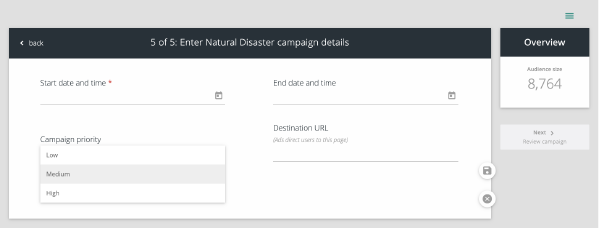
More information on campaign prioritization will be added to the help soon.
(ECOM-5404)
Added new traits
Several new traits for users with a Q2 Goals account have been added to the Insights tab of the campaign builder. You can now target a particular audience based on a specific Q2 Goals account category or percentage completion toward a specific Q2 Goals account category. (ECOM-4831, ECOM-4830)
This release includes the following updates:
Fixes
- Fixed an issue where users were unable to successfully create campaigns. (ECOM-6258)
This release includes the following updates:
What's new
- Added Q2 User ID and Q2 Discover Visitor ID custom audience types. (ECOM-5666)
- Added the ability for users to delete images from their creatives library.
(ECOM-5697)
-
The Users with unfunded goals accounts trait has been added to the Insight tab of the campaign builder. (ECOM-6125)
Fixes
- Fixed an issue where large custom audiences could not be uploaded successfully. (ECOM-5934)
- Fixed an issue where the information users entered in step one of the campaign builder disappeared when they continued to step two and returned to step one. (ECOM-6059)
This release includes the following updates:
Fixes
- Fixed an issue where, when a user made edits to a campaign, some changes would not appear in UUX until the following day. Changes will now display in the Recent activity section of the Home tab and in UUX in a timely manner. (ECOM-5811)
- Fixed an issue where, when a user made edits to a campaign and exited edit mode without saving, the changes still displayed after the user returned to the page. Now, when a user leaves edit mode without saving, the changes are discarded. In addition, an issue was fixed where the Save campaign edits? dialogue box did not display when a user made edits to a campaign and exited edit mode without saving. (ECOM-6009)
This release includes the following update:
What's new
-
Updated internal processes to improve performance and accessibility. (ECOM-6080)
This release includes the following updates:
What's new
Added custom surveys
You can now create custom surveys in SMART. On step 1 of the campaign builder, you now have the option to build a Custom Survey. Once selected, you can create your own survey questions on step 3 of the campaign builder.
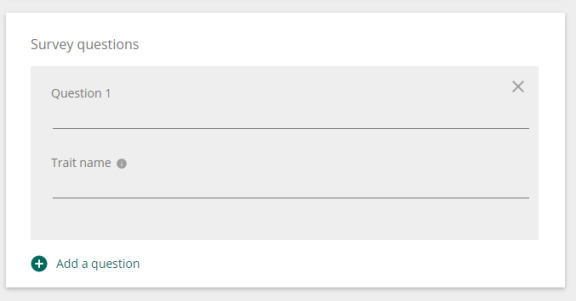
Your users' responses will then become traits that you can use in future campaigns.
For information on creating custom surveys, see Building a survey. (ECOM-5903, ECOM-5638)
Added new traits
The following traits have been added to the Insight tab of the campaign builder:
- Users eligible to enroll in CPFM (ECOM-5828)
- Users enrolled in CPFM (ECOM-5829)
- Users eligible to enroll in Q2 Goals (ECOM-5943)
- Users enrolled in Q2 Goals (ECOM-5944)
- Range of interest rates for External deposit accounts (ECOM-5967)
- Range of interest rates for External loans (ECOM-5987)
- Range of interest rates for External credit cards (ECOM-5988)
Additional changes
- Updated step 3 of the campaign builder to disable the Next button until users define the values for each trait of their audience. Previously, users could advance past this step without defining these values. (ECOM-5691)
- Improved usability of the survey page by breaking up the content blocks into different sections and adding a navigation bar. (ECOM-5928)
Q2 SMART 1.7.4
This release includes the following update:
Fixes
- Fixed an issue where some buttons in surveys were cut off. This issue only occurred in UUX 4.4.0 and later. (ECOM-5864)
Q2 SMART 1.7.3
This release includes the following update:
What's new
- Updated internal processes to improve product tagging. (ECOM-5644)
This release includes the following update:
Fixes
Campaign builder issues
Previously, when a user added a new audience to a campaign that targeted multiple audiences, they were unable to proceed past the Upload creatives page in the campaign builder. On this page, the Next button was disabled until the user changed one of their ads. When the user reached the Review campaign page, their creatives also appeared for each audience set they included in their campaign. Now, when a user edits a campaign, they can proceed past the Upload creatives page and will only see one set of creatives for their campaign. (ECOM-4042)
This release includes the following update:
Fixes
- Fixed an issue where, when a user downloaded a campaign report, the report contained no data on impressions and clicks. (ECOM-5698)
This release includes the following updates:
Fixes
- Fixed an issue where a validation error caused the Campaigns by User API to fail. (ECOM-5692)
- Fixed an issue where users could not edit the Start date and time for a queued campaign. (ECOM-5080)
This release includes the following update:
What's new
- Updated internal processes to prevent login issues. (ECOM-5519)
This release includes the following update:
What's new
- Updated the custom audience feature to shorten upload times and prevent errors in audience sizes. (ECOM-5400)
This release includes the following update:
Fixes
- Fixed an issue where some conversions were counted multiple times, resulting in inaccurate conversion numbers in campaign reports and CSV extracts. (ECOM-5323)
This release includes the following update:
Fixes
- Fixed an issue where, after a user discarded their edits to a campaign, their changes were still saved. (ECOM-5520)
This release includes the following update:
Fixes
- Fixed an issue where impressions were not recorded when end users viewed ads in browsers. (ECOM-5397)
This release includes the following updates:
What's new
New image size requirements for Banner - Top and Banner - Account tile ads
Financial institutions (FIs) can now display the Banner - Top and Banner - Account tile ads in high resolution across different displays and devices.
To improve user experience, Q2 has increased the image size requirements for the following ads:
- Banner - Top - 1280 x 210 pixels
- Banner - Account tile - 768 x 127 pixels
In addition, FIs can now upload image files up to 500 KB for the Banner - Top ad.
All current campaigns will continue to run ads with the previous image sizes. For future campaigns, FIs must upload image files that meet these new requirements. (ECOM-5244)
Fixes
- Fixed an issue where users could not upload custom audiences if their CSV files included non-printable characters. SMART now removes these characters during processing. (ECOM-5240)
This release includes the following updates:
Fixes
- Fixed an issue where, when a user uploaded a custom audience, duplicate entries in their CSV file caused the audience size to inflate. (ECOM-5200)
- Fixed an issue where clicks and impressions in the graphical report and CSV report were inconsistent. (ECOM-5171)
Q2 SMART 1.6.3
This release includes the following updates:
What's new
- Added survey questions and answers to CSV reports. (ECOM-3961)
- Updated the user interface for survey campaigns to improve user experience. (ECOM-4612)
Fixes
- Fixed an issue where campaigns failed to start or stop. (ECOM-5079)
Q2 SMART 1.6.4
This release includes the following updates:
Fixes
- Fixed an issue where corrupted campaigns prevented other campaigns from starting and stopping. (ECOM-4824)
- Fixed an issue on the Usage tab where, when a user searched for a term that returned no matches, the resulting message displayed an empty string rather than the search term. (ECOM-5081)
- Fixed an issue where survey answers were incorrectly marked as seen. (ECOM-5157)
This release includes the following updates:
Fixes
- Fixed an issue where unanswered questions did not reappear when a user returned to a survey. (ECOM-5029)
Q2 SMART 1.6.0
This release includes the following updates:
What's new
- Added traits based on survey results as options for the Target audience of campaigns. (ECOM-4429)
Fixes
- Fixed an issue where additional ad spaces were selected on the creative types page when the user returned to edit the campaign. (ECOM-4554)
- Fixed an issue where text in the Text and icon - Account tile ad did not wrap and appeared outside of the ad. The ad now expands based on the size of the text. (ECOM-4499)
- Fixed an issue where campaigns did not start or end at the specified time. (ECOM-4092)
Q2 SMART 1.6.1
This release includes the following updates:
Fixes
- Fixed an issue where users continued to see ads for a survey they had completed. (ECOM-4622)
- Fixed an issue that prevented users from adding new products to Q2 SMART. (ECOM-5016)
This release includes the following updates:
What's new
Updated ad carousel timing
Based on FI feedback, the following ad locations have been updated to carousel every 10 seconds:
Desktop and tablet
- Banner - Top (full)
- Banner - Sidebar (med)
- Banner - Sidebar (small)
Mobile
- Banner - Sidebar (med)
In the iOS and Android app with native menu, Sidebar (Mobile) and Sidebar (small) ad
locations continue to carousel every 30 seconds.
Additional changes
- Updated the Recommended audience to decrease the variance in audience sizes from day-to-day. (ECOM-4576)
This release includes the following updates:
What's new
Target online banking users with current balance for external products
Added a new feature for FIs with SMART and Contextual PFM that allows SMART ads to target end users based on their current account balance (low, moderate, or high). This new feature is available for external product traits that are selected when creating a campaign. If a user has more than one account in the same product family (such as two savings accounts), the balance for the trait is the total sum of those accounts. (ECOM-3247)
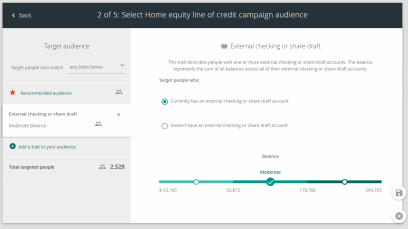
This release includes the following updates:
Fixes
- Fixed an issue where mobile users were unable to close out of the Account Tile ad without restarting the app. (ECOM-3834)
- Fixed an issue where some URLs used for the Mobile only ad redirected to an error page. (ECOM-3838)
- Fixed an issue where, when a user navigated away and back to the Home page, the Account Tile and Side (medium) ads overlapped each other. (ECOM-3934)
This release includes the following update:
What's new
- Minor performance enhancements and/or bug fixes.
This release includes the following update:
What's new
- Minor performance enhancements and/or bug fixes.
Q2 SMART 1.5.6
This release includes the following updates:
What's new
Online Help link
An Online Help link has been added to the SMART app. To access the help,
select the Utility menu ( ) in the upper-right corner of the page. Select the
Help icon (
) in the upper-right corner of the page. Select the
Help icon (![]() )
and then
select Online Help. (ECOM-3821)
)
and then
select Online Help. (ECOM-3821)
Q2 SMART 1.5.6.1
What's new
- Minor performance enhancements.
This release includes the following updates:
What's new
- Performance enhancements and/or bug fixes.
Q2 SMART 1.5.3.1
This release includes the following updates:
What's new
- Performance enhancements and/or bug fixes.
Q2 SMART 1.5.4
This release includes the following updates:
What's new
Microbusiness trait
Microbusiness trait targets people who exhibit behaviors similar to users who own a microbusiness. These users have an above average number of deposits from micropayment processors (like Square, Stripe, PayPal, and Venmo) in the last 90 days. (ECOM-3349)
Central groups trait
Central groups trait allows FIs to target messages to online banking users based on Q2central groups. (ECOM-3113)
This release includes the following updates:
What's new
Campaign builder redesign
Step 1 of the campaign builder now has the Campaign name field. For the campaign builder to move to the next step, the campaign name field is required and must be unique. (ECOM-3140)
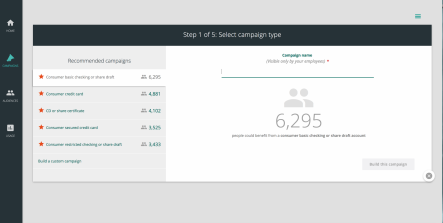
User can select multiple traits at once
In step 2 of the campaign builder, users can now click "Add a trait to your audience." In the modal that opens, users can select multiple traits at once from the various trait tabs to have them added to their campaign. (ECOM-989)
Campaign builder step 3 select ad placement
In step 3 of the campaign builder, users can select one or more ad placements.
Banner - Account tile and Text and icon - Account tile are available to FIs with UUX version 4.3.0.14 and higher. (ECOM-3141)
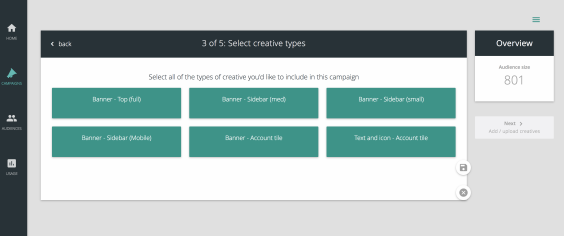
Campaign builder step 4 upload ad images
In step 4 of campaign builder, the ad space placements you selected in step 3 appear. Click in the perforated box to select an image from your library or upload a new ad.
You can then enter alt text for the ad space. Alternative text serves the following purposes:
- screens readers read the text in place of images, allowing the content and function of the image to be accessible to those with visual impairment.
- is displayed in the place of images if the user has chosen to not view images or if the image file is not loaded.
(ECOM-3142)
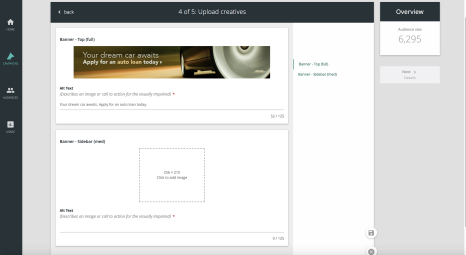
Q2central marketing messages permissions
To access SMART, users will need to have Q2central Rights for COMMUNICATION: ManageMarketing Messaging permission enabled to have a successful login to SMART. (ECOM-3204)
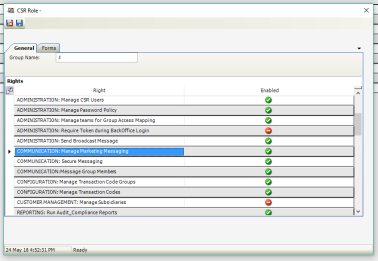
This release includes the following updates:
What's new
SMART spaces: account tile
FIs with UUX version 4.3.0.14 and higher will now have a new space available for messaging. The new space is called account tile and will be available in campaign builder if the UUX environment meets the version requirement. The account tile will appear in UUX on the accounts overview page with the other account tiles. (ECOM-2688)
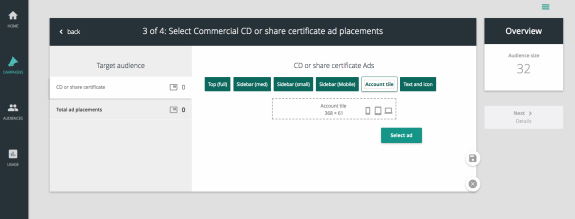
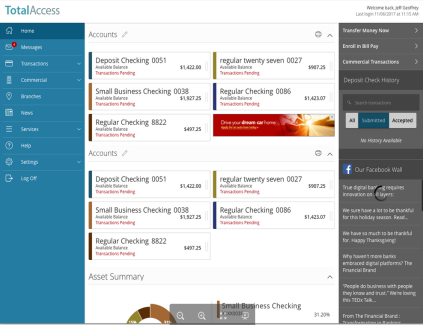
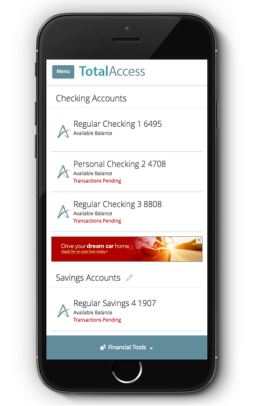
SMART spaces: text with icon space
FIs with UUX version 4.3.0.14 and higher will now have a new space available for messaging. The new space is called text and icon and will be available in campaign builder if the UUX environment meets the version requirement. The text and icon space will appear in UUX on the accounts overview page under the account group. (ECOM-2690)
![]()

![]()
Additional changes
Prevent resume of campaign with missing elements
If a campaign does not include an audience or creative, SMART will prevent the campaign from launching and place it in a paused state. When a user clicks Resume campaign, SMART will prompt the user to go through campaign builder to add the missing element(s). (ECOM-2905)
URL character length
In step 4 of campaign builder we have extended the URL character length to 500 characters. (ECOM-3008)
Host code added to product tagging
Host code has been added to the product tagging as a unique identifier for tagging FI's products. (ECOM-3085)

Product tagging update
We have removed the third level of product tagging (descriptors). FIs can use the card view or list view to tag their products. Be advised, for the product tagging to save, each product must be tagged down to the second level (Type and then Tag). (ECOM-2577)

External traits usage reporting
External traits usage reporting displays the account type at a top level and then allows the user to drill down to number of accounts and number of FIs with held away accounts. (ECOM-3002)
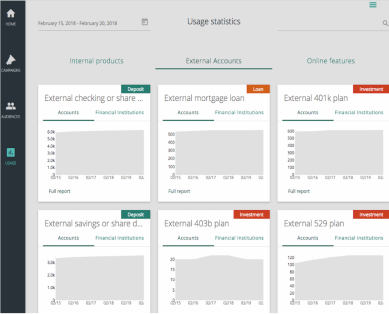
This release includes the following updates:
What's new
Create audiences using external traits—Contextual PFM
External product traits are available in Q2 SMART for FIs that have purchased Q2's Contextual PFM product. This first version of external product traits in SMART allows FIs to target OLB users who have or do not have held-away accounts.
If your FI has Contextual PFM you can access external product traits in step 2 of the Campaign builder by clicking Add a trait to your audience. Then, when the trait modal opens, click External products.
This release includes the following updates:
What's new
Import customer audience success/failure rate
After a user uploads a new audience, SMART displays the number of active online banking users along with a fraction. The fraction numerator represents the number of inactive online banking users, or failed imports. The denominator represents the total number of users attempted, or the total number of identifiers in the uploaded list.
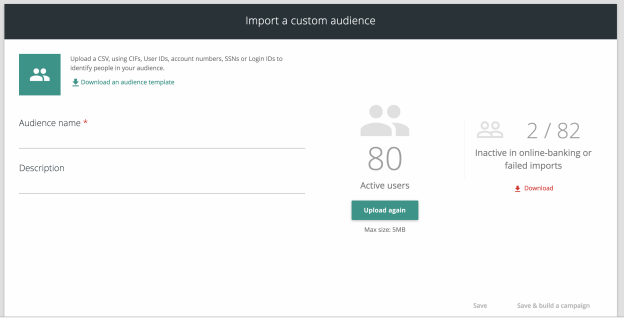
(ECOM-2622)
Campaign results page includes conversions
The campaign results page has Conversions in the right most green box, which replaced product adoptions.
This now gives a more accurate visual of the campaign funnel.
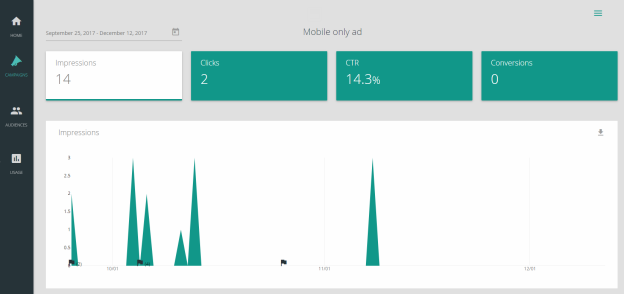
(ECOM-2512)
Review audiences before campaign launches
You can now view an audience before launching a campaign. In the Campaigns page, find the Campaign you
want to review and click the More icon ( ). From the
More menu, click View Audience.
). From the
More menu, click View Audience.
The comma-separated value (CSV) file containing the audience information is ready for download. (ECOM-2703)
This release includes the following updates:
What's new
Product tagging PC multi-select
In the card view of product tagging, PC users can now select multiple, non-sequential products from the Unsorted column by clicking a product, and then holding down the Ctrl-key while you click other products for tagging. (ECOM-2541)
User guide in the application
Users can access the
Q2 SMART user guide from the Utility menu ( ) by clicking
) by clicking ![]() >
Help Index. This opens the
Q2 SMART User guide (PDF) in a new browser tab.
>
Help Index. This opens the
Q2 SMART User guide (PDF) in a new browser tab.
(ECOM-570)
This section describes new features and enhancements in the Q2 SMART 1.4.0 release of September 2017.
What's new
This release includes the following updates:
Product tagging
Product tagging is now available in the Products page and allows financial institutions (FIs) to map their products into predetermined Q2 SMART product categories. The workflow for Product tagging requires that a product be assigned first to a Type, then a Tag, and lastly a Descriptor. The following shows some examples of how Products might be tagged.
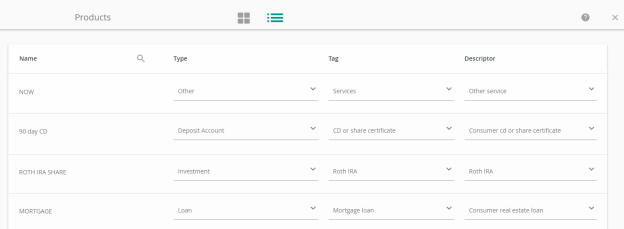
This feature provides two views—List and Card.
To access Product tagging
- Click the Utility menu (
 ) in the upper right corner of
the page and select the Tag (
) in the upper right corner of
the page and select the Tag ( ) icon to display the Products page.
) icon to display the Products page.
Products page—(Default) Card view
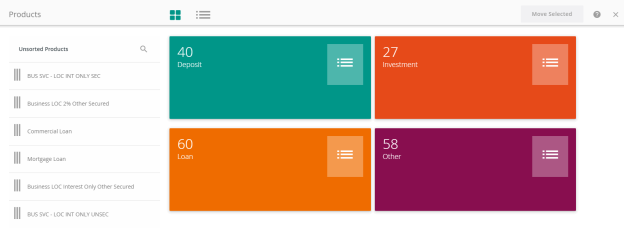
The Products page defaults to the Card view, but you can change views using the View icons at the top of the page.
View icons
![]()
Card view
The Card view offers drag and drop functionality, to easily move unsorted Products into categories. Once Products are moved to Product Type and then Product Tag categories, you will need to add Product Descriptors. Click the Product Tag category and select the appropriate Descriptor from the drop-down list. If you made a mistake, find the product in the list view and re-categorize it.
Product multi select
In the Product tagging UI, you can select multiple items and drag them at once.
To select multiple products for tagging
- Do one of the following:
- Click Ctrl (or Cmd for Mac users) + clicking multiple items
- Click Shift + clicking between the top and bottom items to select all of the items in between
List view
- The List view is made up of Name, Type, Tag, and Descriptor columns
- Name column is the FI’s list of products
- Type, Tag, and Description columns have drop-down lists. Each drop-down selection determines the next column’s available selections in decision tree format.
- The search function uses a text query to search items in the Name column
- Sorting is available for each column in the List view
Products page—List view

(ECOM-1756, ECOM-1757, ECOM-1835, and ECOM-2057)
Additional changes
Help tutorials
Help tutorials are now available through the Utility menu to assist you with working with UI functionality.
To access the Help tutorials
- Select the Utility menu (
 ) and the Help (
) and the Help ( )
icon.
)
icon.
- A tutorial box opens, guiding you through the functionality of important UI elements.
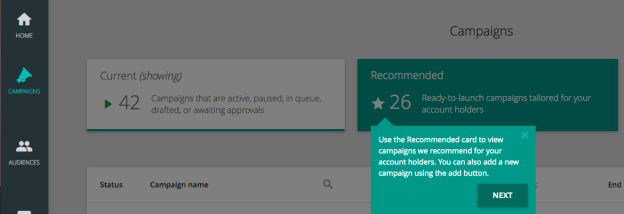
(ECOM-561 and ECOM-2059)
Multiple hover state flags in Campaign Reporting
In the campaign report graph, when multiple events happen on a single day, the graph displays the number of events on that day next to a flag.
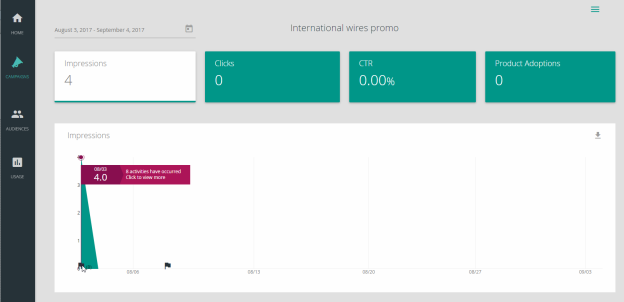
(ECOM-1700)
Mobile only ad space
In step 3 of the Campaign Builder, a fourth ad type has been created for mobile only ads. The new space is called Sidebar (Mobile) and is 256 x 84. Select the Sidebar (Mobile) ad type to serve ads exclusively to mobile devices.
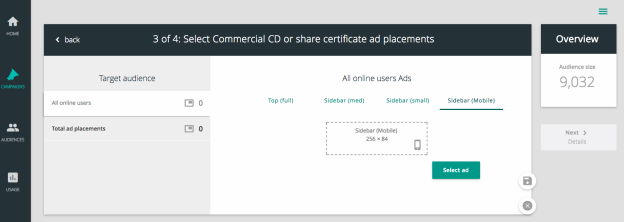
(ECOM-2178 and ECOM-2179)
Reporting enhancements
This release of Q2 SMART includes a number of reporting improvements.
Previously, click-through rates (CTR) had been reported as calculating different numbers on the campaigns page versus what was displayed on the Campaign View Report page. This was because there was a defect in the calendar default section on the Campaign View report page. Now, the Campaign page and the View Report page default to the full length of the campaign. If the campaign is in progress it will default to the start date through today’s date.
This release also includes improvements to impressions and conversion counts.
Impressions are only counted the first time the impression is shown to a user with a unique user ID per page. If the ad carousels through multiple times during a user’s visit to a page, the impression will only be counted the first time on that page. If the user clicks the ad multiple times during the campaign and converts, the conversion will only be counted once.
(ECOM-2188, ECOM-2254, ECOM-2219, and ECOM-2181)
This release includes the following updates:
What's new
Saving changes
If a user clicks the Utility menu icon (![]() ) and then clicks Log off, a message prompts the
user to save changes if the user was in the middle of a workflow, such as editing an audience. In
previous releases, a user could lose work when logging off during an active workflow.
) and then clicks Log off, a message prompts the
user to save changes if the user was in the middle of a workflow, such as editing an audience. In
previous releases, a user could lose work when logging off during an active workflow.
Ad library filter
All creative assets previously uploaded to SMART will be present in the "Select your ad" library. If creative has previously been used for a specific type of campaign, that creative will be at the top of the page. All other creative appears in the chronological order it was uploaded.
This section describes new features and enhancements in the Q2 SMART 1.3.0 release provided to a limited audience in June 2017.
What's new
Utility menu
A Utility menu (![]() ) appears at the top of each
SMART page. Click the menu to display the
following window where you can click Log off to save changes and exit, or
click Close to shut the menu.
) appears at the top of each
SMART page. Click the menu to display the
following window where you can click Log off to save changes and exit, or
click Close to shut the menu.
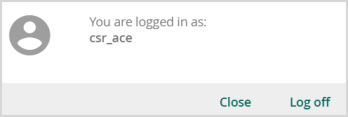
If you are in the middle of making changes (for example, editing an audience), changes will not be saved if you click Log off. Be sure to complete an active workflow before logging off.
Additional changes
Previewing devices where ads appear
When placing ads, small icons appear for each device (smartphone, desktop, or tablet) that supports the ad.
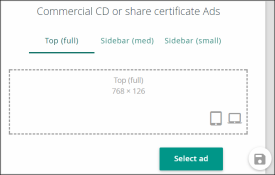
Password reset instructions on Login page
Text was added to the Login page to indicate that FI staff can manage passwords in Q2central.
Campaign report change flags
Users can hover over graphs to display more data. Flags appear on reports to indicate if changes occurred, as shown here.
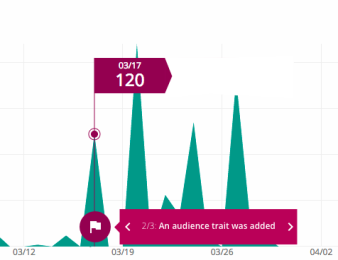
This release includes the following updates:
What's new
Product binary traits appear if user has product
In previous versions, you could select to target end users if they "had ever had" or "had never had" a certain product.
This trait was updated to be more specific, so you can now target users who currently have or do not have a certain product category.
Product trait - Campaign workflow
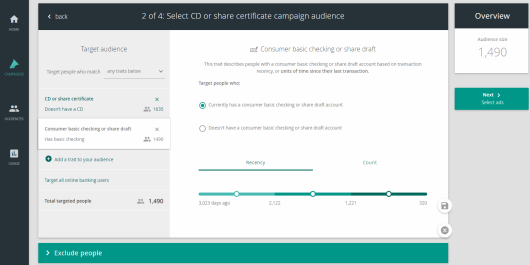
(ECOM-1228)
Product Count trait
Product Count is a new, product-level trait that allows FI staff to target end users with a certain number of any given account type (for example, three auto loans).
(ECOM-1611)
Additional changes
- You are no longer required to enter a destination URL for a campaign. (ECOM-1150)
- Several other minor updates to the UI.
This release includes the following updates:
What's new
Tooltips
FI staff can now view helpful tooltips in hover-text form on certain icons on specific SMART pages. For example, the Status icons in the Campaigns list.
To see a tooltip
- Hover your cursor over the icon to see the tooltip text.
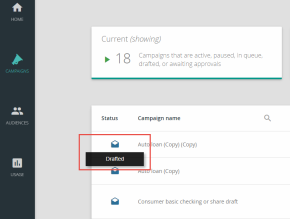
Additional changes
- The version number now appears on the login page.
- Added Save and Cancel buttons to the Campaign Builder workflow.
- Added an Adoptions column to the Campaign Report.
- FI staff can see which individual users were targeted in a campaign and clicked ads. They can also see if users adopted the product category in the time frame of the campaign.
- FI staff can see adoptions in the Campaign Dashboard.
Q2 SMART 1.1.1
This release includes the following updates:
What's new
All products were given new product tags and were re-sorted. The result is a dramatic change in the user interface, which allows the system to provide more specific audience targeting and product recommendations. This also resolves several small issues in the user interface (UI).
Additional changes
- The campaign report now shows end users targeted by a campaign, plus which campaign ad the end users clicked.
- FI staff can now upload larger audiences.
Q2 SMART 1.1.2
This release includes the following updates:
What's new
Individual report view
In the Usage section, you can now see a Full Report with more detailed engagement information about each product category and online banking feature.
Download product and feature Usage Statistics
In the Usage section, you can now download a simple CSV report with the daily engagement numbers in the Individual Report view.
Export Custom Uploaded Audience
In the Audiences section, you can now download custom audience lists that you upload, so you can review the uploaded lists.
Additional changes
- The Campaign Performance page is now the Home page.
This release includes the following updates:
What's new
Usage dashboard
A new Usage tab was added to the left navigation pane. This tab allows you to access the Usage page, which contains an aggregated view of product adoption and feature usage in an easy-to-consume dashboard.
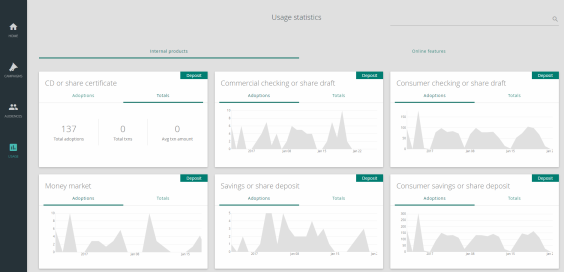
Campaign engagement report
You can now download a detailed report on campaign engagement statistics in a CSV format. This report shows how individual users interacted with ads, sorted by user ID. Each report shows both impressions (that is, the number of times ads were served to a user) and clicks on ads.
To download this report
- Select the Campaigns tab.
- Select More (
 ) next to the desired
campaign.
) next to the desired
campaign.
- Select Export Results.
Campaign adoptions
When you view a campaign report, you can now see the number of product adoptions for the campaign. Adoptions are the number of products adopted within the category of the product targeted by the campaign within the campaign’s timeframe. For campaigns promoting a feature, adoptions reflect the number of times a user engaged with the feature targeted by the campaign.
To view product adoptions
- Complete one of the following:
- On the Campaigns page,
select More (
 ) next to the desired
campaign, and
select View Report.
) next to the desired
campaign, and
select View Report.
- On the Home page, select the Campaign performance view. Then, scroll to the desired campaign card and select Full Report.
- On the campaign report, select Product Adoptions.
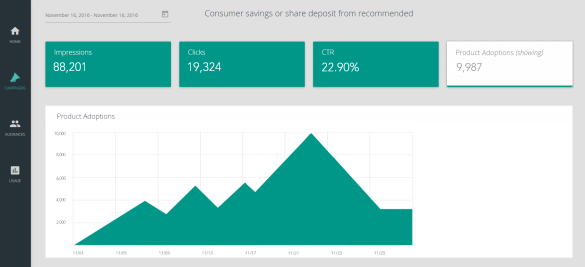
Ad serving
SMART now serves ads to every page in online banking where the targeted ad space is configured. You can target ads in the Top Banner, Side (small), and Side (medium) locations. These locations exist on the Home page, but also exist on other online banking pages depending on how ads were configured during implementation.
Impression tracking
This release includes improved accuracy of impression tracking in the Q2mobility Apps.
Ad rotation
Q2 SMART 1.1.0 contains improved ad rotation. If a user is targeted by multiple ads, the ads will rotate every 30 seconds and count as an impression in both Q2online and the Q2mobility Apps.
Optimized mobile ad space
For Mobile Container 5.2.0 or later, Side (small) ads served by SMART appear in the left slide-out rail instead of the right slide-out rail. Side (medium) ads still appear in the right slide-out rail. If multiple ads target the user, ads will rotate every 30 seconds.
Side (small) ad in the mobile ad space
